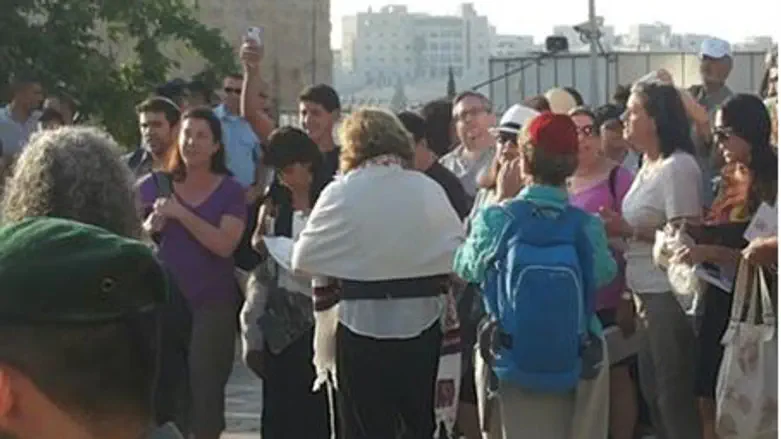
In the ongoing dispute within the Jewish world regarding women's prayer at the Kotel, the morning Rosh Chodesh (new month) prayers at the Kotel appear to have been a victory for the Orthodox stream. Hareidi religious women came to the prayer en masse, while the Women of the Wall – New Israel Fund backed provocateurs who insist on praying while donning men's religious garb and accessories – showed up in much smaller numbers. As a result, police did not let the Women of the Wall into the women's section next to the Wall, but fenced off a small area at the entrance to the Kotel Plaza for them to pray in.
The women's section of the Kotel Plaza has turned into a scene of direct confrontation between Orthodox and anti-Orthodox Jews in recent months, as the Women of the Wall insist on fanning the flames of the dispute.
According to Voice of Israel public radio, about 150 Women of the Wall came to the Plaza Monday morning but police prevented them from praying there, although they had previously set aside an area for them within the women's section.
Police said that there was no room left for the Women of the Wall, because 5,000 Orthodox ulpana students had showed up and filled the Plaza. In addition, hundreds of hareidi men made it difficult for the Women of the Wall to even enter the Plaza. Police allowed the Women of the Wall to pray at the entrance to the Plaza.
One ulpana girl was arrrested for allegedly disorderly behavior.
Women of the Wall accused police of surrendering to “hareidi thuggery.”
Dangerous divisiveness or healthy pluralism?
The Women of the Wall are a group of women who insist upon praying at the Kotel – one of Judaism's holiest sites and its most important active prayer location – while wearing the tallit prayer shawl, the kippa head covering, and sometimes tefillin, or phylacteries – all of which are customarily worn by men. In addition, the women read aloud from the Torah during the group prayer session – an act which Orthodox religious practice reserves for men.
The Women of the Wall are a tiny group, numerically, but they receive great support from most of Israel's media, which sees them as the face of a more open and friendly brand of Judaism, and an alternative to conservative forces that the media generally views with suspicion. Much of the liberal criticism of Orthodox Judaism centers upon the concept of distinct yet complementary male and female roles, which are a central tenet of its moral code, religious tradition and social norms.
Liberals claim that making distinctions between men and women's roles is a form of unfair discrimination that keeps women away from positions of power. By having women don men's traditional garb and read from the Torah, they are challenging this perceived discrimination and making a more general political statement, regarding what they say is a moral glass ceiling, buttressed by religion, that keeps women away from the seats of authority.
The group receives funding from the New Israel Fund (NIF), a highly controversial fund that has an ongoing partnership with the Ford Foundation. The New Israel Fund is closely associated with former Meretz Knesset Member, Prof. Naomi Chazan, who served as its president for many years. It was the focus of a heated dispute in recent years after it became known that 92% of the “Israeli” quotes (i.e., quotes from Israeli sources) in the Goldstone Report came from organizations funded by the NIF.
The Goldstone Report was filed by a United Nations commission – later discredited, even by its own chairman – that blasted Israel for alleged war crimes in the 2008-9 Cast Lead counter-terror operation in Gaza. Chazan was also a co-signatory on a petition that called on the IDF to stop “the massacre” in Gaza, just 24 hours into the operation.
The New Israel Fund specializes in organizing and funding anti-establishmentary forces in Israel – from radical Arab groups, to illegal work immigrants, to extreme "feminist" groups – thus stirring up what some would call dangerous divisions. Others see the groups as representing what democracy, pluralism and open debate within society are all about.
Photos by News24